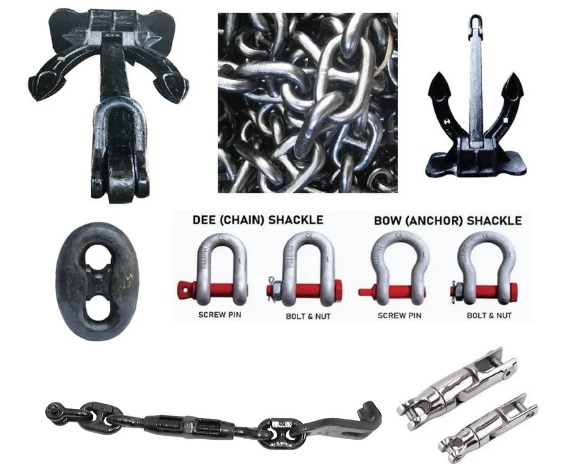
Anchor – Anchors are critical components of a ship’s mooring and docking systems, serving primarily to secure the vessel in place while at rest. When a ship drops anchor, it is designed to dig into the seabed, providing resistance against the forces of wind, currents, and waves that can cause it to drift. This function is vital for maintaining safety and stability, especially in harbors, during cargo operations, or while conducting offshore activities. Anchors come in various types and sizes, including fluke, plow, and claw anchors, each designed for different seabed conditions and vessel sizes. In addition to their primary role in mooring, anchors are essential for emergency situations. Should a ship experience mechanical failure or adverse weather conditions, an anchor can provide a means of preventing drift, allowing the crew to stabilize the vessel until assistance arrives or repairs can be made. The anchor system typically includes a chain or rope that connects the anchor to the ship, enabling easy deployment and retrieval. Regular inspection and maintenance of the anchor and its associated equipment are necessary to ensure reliable operation. Ultimately, anchors play a crucial role in maritime safety and operational efficiency, contributing to the overall effectiveness of a ship’s navigation and docking procedures.
Anchor chain – Anchor chains are critical components in a ship’s anchoring system, providing the necessary strength and weight to secure a vessel in place when moored or anchored. These heavy-duty chains are designed to withstand the immense forces exerted by wind, currents, and tides, ensuring that the ship remains stable and does not drift away from its designated location. Made from high-strength steel, anchor chains offer superior durability and resistance to corrosion, which is essential given their exposure to harsh marine environments. The anchor chain plays a crucial role in the effective functioning of the anchor itself. It connects the anchor to the ship and allows for a smoother deployment and retrieval process. The weight of the chain helps to keep the anchor in a vertical position when deployed, increasing its holding power by embedding it securely into the seabed. This ensures the anchor grips well and minimizes the risk of dragging. Additionally, the length of the anchor chain is important, as it affects the scope of the anchoring system; a longer chain allows for better holding power and adaptability to changing water depths. Overall, anchor chains are indispensable for ensuring the safety and stability of ships during anchorage and mooring operations.
Shackles – Shackles are critical components in maritime operations, serving as essential links in the rigging and anchoring systems of ships. Primarily made from robust materials like steel, shackles are designed to securely connect chains, ropes, and other rigging equipment, ensuring reliable and safe load-bearing capabilities. Their versatility allows them to be used in various applications, including mooring, towing, and lifting heavy loads. When anchoring a ship, shackles connect the anchor chain to the anchor itself, providing a secure attachment that withstands the stresses of wind and tide. In addition to anchoring, shackles are used in cargo handling operations, where they facilitate the secure attachment of lifting slings or hooks to cargo loads, enabling safe and efficient lifting and moving. They are also integral to rigging systems, connecting components such as blocks, pulleys, and wires, which are crucial for adjusting sails and managing other onboard equipment. Various types of shackles, including D-shackles, bow shackles, and screw-pin shackles, cater to different applications, providing the necessary strength and functionality for specific tasks. Overall, shackles are vital for ensuring safety and efficiency in maritime operations, enabling ships to operate effectively in diverse marine environments.
Swivels – Swivels are essential components in the rigging and operational systems of ships, providing versatility and functionality in various maritime applications. Primarily used to connect two lines or pieces of equipment, swivels allow for rotational movement, preventing tangling and kinking of ropes, cables, or chains. This is particularly important in the context of mooring, towing, and anchoring, where the ability of a line to rotate freely can significantly reduce stress and wear on both the line and the attachment points. In ship operations, swivels are commonly utilized in towing arrangements, allowing for smoother maneuvers and reducing the risk of equipment failure. They are also crucial in the deployment and retrieval of anchors, where the rotational freedom can help maintain the integrity of the anchor chain. Furthermore, swivels are often used in conjunction with pulleys and blocks in lifting operations, facilitating the efficient transfer of loads without compromising safety. Made from durable materials such as stainless steel or heavy-duty alloys, swivels are designed to withstand harsh marine environments, including corrosion from saltwater exposure. Overall, the use of swivels enhances the safety, efficiency, and longevity of various ship operations, making them indispensable in maritime activities.
Chain Stopper – A chain stopper is a critical piece of equipment on ships, specifically designed for managing anchor chains and ensuring safe anchoring operations. It serves as a secure mechanism to hold the anchor chain in place, preventing it from slipping or releasing unexpectedly while the vessel is at anchor. By gripping the chain, the chain stopper alleviates the tension on the windlass, the equipment used to raise or lower the anchor, thus prolonging its lifespan and ensuring smooth operation. Chain stoppers are particularly important during rough sea conditions, where the vessel may experience significant movement due to waves and wind. By holding the anchor chain securely, the chain stopper minimizes the risk of the anchor dragging or the chain becoming slack, which could lead to accidents or loss of position. Additionally, chain stoppers are equipped with release mechanisms that allow for controlled operation when the anchor needs to be raised or adjusted. Proper use and maintenance of chain stoppers are essential for ensuring the safety of the crew, vessel, and environment. Overall, chain stoppers play a vital role in effective anchoring operations, contributing to the overall stability and safety of maritime activities.
